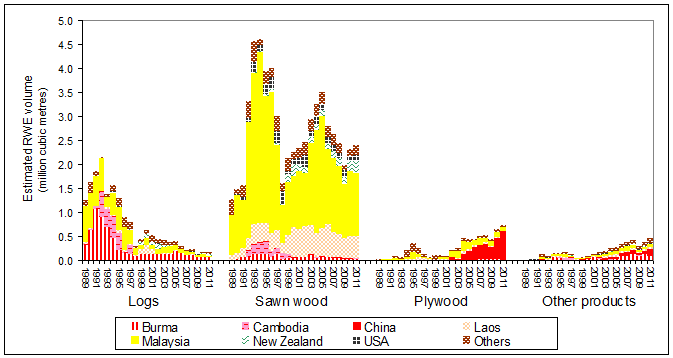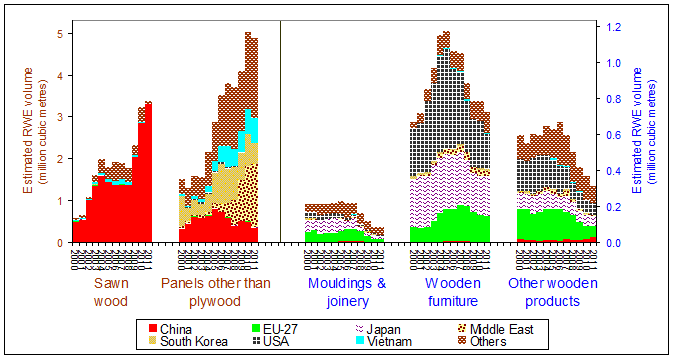|
|
||
|
Thailand The great majority of Thailand's wood processing industry is based on tree plantations (mainly rubber and acacia). Few of the illegalities associated with supplies from forest arise, particularly if the supplier of logs is a smallholder. Thailand's timber imports tend either to enter end-use within Thailand or to be exported as composites deriving partly from tree plantations. These exports would be as illegal as the imported wood-based raw material from which they are at least partly made. Logging has been prohibited in Thailand's forests since 1989. However, illegal logging is widespread, particularly in the north and north east. The origin of at least some of the timber which Thailand records as imports from neighbouring countries is forest in Thailand. A very small proportion of the timber sector and paper sector products which Thailand exports are destined for the EU - with one exception, wooden furniture. Most of this is likely to derive wholly from either rubberwood or teak plantations. Chart 1 - Thailand's imports of timber{Footnote
1} Chart 1 shows that almost all Thailand's imports of timber are supplied from countries whose timber exports are believed to include substantial quantities of Illegal Timber.[Burma][Cambodia][China][Laos] [Sarawak and Peninuslar Malaysia have each supplied roughly 40% of the sawn wood which Malaysia has exported during recent years to Thailand. It is widely understood that most of Malaysia's exports of illegal timber are supplied from Sarawak.[Malaysia] The logging ban prompted the substantial increase of the early 1990s. The decline during 1998 is attributable primarily to recession. Thailand imported large quantities of timber from Burma and Cambodia during the 1990s. The 1989 logging ban destabilised the industry in neighbouring countries - from where Thai enterprises sought to procure timber by way of substitutes for the large volumes which had previously been logged from forest in Thailand. In a number of cases, this has involved collusion with warring factions in Burma's persistent civil war.[p59-70] Some Thai groups have owned sawmills and/or been granted logging concessions in these countries.[*][p60] Much of the illegal logging in Thailand is driven by wealthy individuals (including politicians).[nai tun & jao por] It appears that the Thai military and others are complicit in at least some of this, including at a senior level.{Footnote 2} This tends to indicate that illegal logging is both lucrative and large scale.[second ¶, p64][*][*] The laundering of timber logged illegally in Thailand seems common practise - either by transporting the timber into a neighbouring country and returning it from that country or by falsely asserting that the timber is from the neighbouring country (perhaps after agreement has been reached to reduce supposed long-accumulated stockpiles in the neighbouring country). A number of people (including Cambodian soldiers)[*] have been shot along the border between Thailand and Cambodia allegedly for illegal logging[*] and this has raised tension between the two countries.[*] Not only do the authorities seem keener to arrest local forest people than outsiders for illegal logging[*][*] but the government has recently passed a law which seems considerably to reduce the rights of forest communities to their own land.[fourth ¶] Perhaps coincidently given the political turmoil in Thailand, illegal logging in Thailand is said to have increased during 2008. At least some of the logs and sawn wood which are supplied to the market in Thailand either from imports or from forest within Thailand is subsequently exported with or without further processing.{Footnote 3} Burma and Laos are likely to be the documented origin of the volume which is re-exported (i.e. exported without further processing).{Footnote 4} Much of the timber which has been logged illegally in Thailand is probably exported, particularly as flooring, furniture and ornaments (including as composites with wood raw material from plantations). Some might be supplied with little transformation to markets elsewhere (most probably to China)[*] which tend to be willing to pay large sums for rare species of high quality, irrespective of the wood's legality or sustainability.{Footnote 5} Dalbergia cochinchinensis (a species of rosewood) is a particular target for illegal loggers, both in Thailand and in Cambodia. Efforts to list this species under CITES lack political will.[*] It is likely that at least some of the wooden furniture which Thailand exports (including to the EU and the USA - both of which prohibit the direct import of timber from Burma) is made from timber imported from Burma.[*] However, most of the weight of wooden furniture (perhaps more than 80% )[seventh ¶][fourth ¶, p59¶] which is exported from Thailand is made wholly of rubberwood. Some of the remainder is likely to be made wholly from other species grown on plantations, notably teak.{Footnote 6} The moulding & joinery and other wooden products shown in Chart 2 below are likely to comprise either rubberwood, tropical species, or a composite of the two. Rubberwood and other species from tree plantations account for almost all the large quantity of sawn wood and panels other than plywood which are exported from Thailand. Chart 2 - Thailand's exports of timber{Footnote
1} Conclusion: Substantial volumes of Illegal Timber enter the market in Thailand, both as imports from neighbouring countries or as a consequence of illegal logging within Thailand. Logging in forest is prohibited in Thailand. The Thai military and a number of influential individuals are understood to have significant interest in this. It is unclear how much Illegal Timber leaves Thailand for end-use elsewhere. Although China is particularly likely to be a destination for sawn wood smuggled out of Thailand, manufactured products which are officially recorded as exports to the EU, Japan and the USA might account for a greater quantity in terms of export value. Footnote 1: Source: based on The Customs Department of the Kingdom of Thailand[*], UN Comtrade[*] and World Trade . Footnote 2: Renewed pressure from Thai groups to log in Karen state coincided with the time when Thaksim Shinawatra was Prime Minister [fourth ¶, p77] Footnote 3: Plywood and other products are likely to enter end-use within Thailand. Footnote 4: Exporting through Thailand might be more cost-effective than directly or via China and Vietnam. The volume entering Thailand either from Cambodia via Laos or Burma via Malaysia is probably small - but not insignificant. It is unlikely to be cost-effective for suppliers in Malaysia to export via Thailand. Footnote 5: The volume of logs and sawn wood of species other than rubberwood which Thailand reports as exports to China are small. The large volume of sawn wood which Thailand reports as rubberwood very probably is rubberwood. Footnote 6: The difference between teak from Burma (the only country where almost all teak production derives from forest) and teak grown elsewhere (invariably on plantations) tends to be easily discernible if the wood has not been stained or painted. |
||
|
|
||


